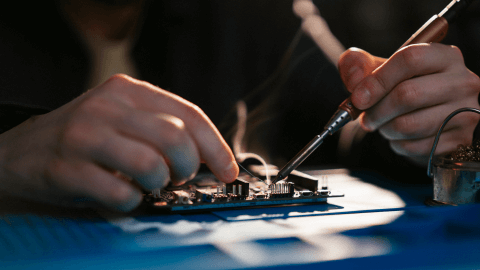The race for the most effective wireless communication technologies becomes more acute due to increasing IoT development services. Using the best data transmission tools means gaining ground on the market. IoT device manufacturers pay attention to energy consumption, the duration the transmission takes, and the security of the wireless communication tool. They can't go with a technology that is an energy consumption overkill or takes too long to set up stable communications. IoT is about speed and steadiness since users don't want to constantly reconfigure their devices.
CHECK OUT: Embedded development services at Lemberg Solutions
LTE-M and LoRaWAN have proved to run like clockwork when it comes to data transmission. LoRaWAN was created by the LoRa Alliance — a non-profit organization that standardizes LPWAN and advances LoRaWAN. They aim to encourage global LoRaWAN use in order to build a more stable future for IoT product development.
However, one more player is competing for supremacy in the IoT industry — Narrowband IoT (NB-IoT), which is similar to LoRaWAN in terms of transmitting little pieces of information. NB-IoT, also called LTE Cat-M2, is a low-power wide-area network (LPWAN) technology that doesn't work the same way as LTE. NB-IoT is a standard independent from LTE and requires a separate infrastructure. It either uses 200-kHz bands that are typical to GSM or gets set up on LTE stations. This tool was developed in a joint effort between 3GPP, Vodafone, Huawei, Qualcomm, and Ericsson, becoming a leading-edge wireless network technology in the present day.
In this article, LS Embedded Engineer Serhii Hudym will explain more about NB-IoT and LoRaWAN use cases, and why you should choose them for your IoT project.
How does LoRaWAN work?
Before getting into detail about LoRaWAN, let’s sort out what LoRa modulation is. LoRa is a modulation technology based on the combination of extended-spectrum modulation, Chirp Spread Spectrum (CSS), and Forward Error Correction (FEC) that ensures a considerably larger coverage area when contrasted with other competing methods.
LoRa technology also boosts receiver sensitivity and applies the entire channel bandwidth, which makes it resistant to channel noise and frequency shifts resulting from imprecise frequency configuration. On top of that, LoRa makes the demodulation of signals 19.5 dB below the noise level possible, while a majority of technologies with Frequency Shift Keying (FSK) need 8-10 dB above the noise level to demodulate a signal.
While LoRa is a physical layer, LoRaWAN is a MAC protocol for high capacity, long range, and low native-power consumption. LoRaWAN is an open standard accessible to anyone who wants to establish a reliable IoT network at a low price.
LoRaWAN ensures long-range communication between sensors and IoT devices up to a 20 km distance. This technology employs a 0.3KBps to 50KBps data transfer rate that depends on the conditions of its location. LoRaWAN is usually a great option for businesses that need their products to function steadily in distant places – like construction areas or mines.
LoRaWAN allows performance on low power, while also being on an unlicensed band. This protocol provides full two-way communication, and its architecture guarantees the reliability and safety of the whole system. The LoRaWAN architecture has also been developed to ease moving object detection for business asset tracking.
How does NB-IoT work?
NB-IoT was created for device connection by narrow spectrum bands below 200 kHz. Even though NB-IoT is a low-speed network with only 250 kbit per second, it offers the most important advantage for IoT manufacturers — stable data transmission.
When the modem starts to connect with the device, it calls the base station which establishes the connection. When the communication channel is occupied, the modem switches to EDRX and PSM — the principal methods of decreased power consumption. It also goes dormant when waiting for a new data transmission set.
Since NB-IoT was created as a global standard, it can be used in numerous areas by different companies using mobile virtual network operators (MVNOs). NB-IoT is much more convenient in use than LoRaWAN, which requires building an infrastructure (a base station to which the devices should connect) – because NB-IoT doesn't depend on such infrastructure and uses a mobile operator’s infrastructure.
Benefits of NB-IoT comparing to LoRaWAN
In addition to being global standards that make NB-IoT and LoRaWAN suitable technologies to work with if you are planning to develop an IoT system, LoRaWAN and NB-IoT deployment is a cost-effective and energy-saving decision.
Here are the underlying NB-IoT perks that make it so widely used:
- NB-IoT allows for low power consumption. IoT systems working with the help of NB-IoT serve longer without the need to be charged because its performance conserves energy, allowing the battery to function for up to ten years. Engineers can set the device’s switch on a dormant mode when they don't need to be activated. Thus, manufacturers don't rely on nonstop cellular connection for the system's stable communication.
- It is a secure solution. Speaking of NB-IoT security, this carrier-class network is safe for your data since it is subject to the LTE standard.
- NB-IoT also has wide coverage, so engineers are not strictly restrained when it comes to the development of devices that have to be relatively far from one another. This is especially important for industrial IoT and devices like smoke detectors, industrial monitors, and smart agriculture. NB-IoT networks can even join devices that are placed inside industrial constructions, solving connection issues in inaccessible areas.
- NB-IoT is a relatively cheap solution because the chips for its production are low-cost due to their simplicity.
Since NB-IoT and LoRaWAN were designed specifically for low-power consumption, they both switch the devices to sleep mode when data transmission is not required.
Nonetheless, LoRaWAN is a more energy-saving technology than NB-IoT. If your goal is to reduce the maintenance of the IoT system you use — LoRaWAN will match this requirement. Additionally, LoRaWAN is a cheaper IoT network alternative compared to NB-IoT.
In terms of security though, NB-IoT's encryption is safer since LoRaWAN is built on AES 128-bit encryption. If you are looking for an industrial IoT solution that will make your data transmission secure, pay attention to NB-IoT, which is a licensed technology. Even though it will cost more, the data security options it provides are better in the long run.
Where are NB-IoT and LoRaWAN used?
Usually, NB-IoT and LoRaWAN aren't used for consumer IoT devices, being more of a match for industrial IoT. Its stability makes it an excellent tool to use in factories and big enterprises in order to control manufacturing processes or personnel safety. LoRaWAN and NB-IoT sensors are also a good choice for the healthcare industry since they help with tracking patients’ health, and their stability makes them one of the most reliable data transmission networks for the IoT.
Other NB-IoT and LoRaWAN applications include:
- Smart metering (electricity, water, and gas)
- Intruder and fire alarms for commercial and private properties
- Measuring health parameters
- Smart city
These technologies allow connecting multiple devices without great difficulty since their implementation is quick and simple. So, if you have an IoT project for smart metering, NB-IoT and LoRaWAN will help with a steady and long-lasting communication between devices.
Wrapup
When you think of stability in data transmission, the first things that should come to mind are LoRaWAN and NB-IoT standards. The focus of these technologies is on making the connection between IoT system devices reliable. Being a part of the LTE standard, NB-IoT depends on a mobile operator’s infrastructure, while LoRaWAN is a global standard promoted by the LoRa Alliance, requiring the configuration of separate base stations.
The manufacturers prefer LoRaWAN and NB-IoT because they are low-priced and maintain long battery life. With these data transmission networks, you can forget about charging your device for almost ten years. This benefit is highly crucial for industrial IoT systems since they consume large amounts of energy. As a rule, LoRaWAN and NB-IoT are used for smart metering to read gas, water, and electricity meters. Considering how much data has to be transmitted, manufacturers need a network that doesn’t excessively use up battery life.
Although LoRaWAN and NB-IoT are similar in numerous ways, you should note that LoRaWAN is less power-consuming than NB-IoT. If you plan to decrease the IoT system maintenance — LoRaWAN is the right choice for you. Also, LoRaWAN is overall cheaper than NB-IoT. However, if you need to make your IoT solution more secure, you should bear in mind that NB-IoT’s data encryption is safer.
Embedded engineers at Lemberg Solutions are well-experienced in developing IoT systems, both for industrial and consumer needs. We will help you choose the right data transmission technology for your business and create the whole infrastructure from scratch. If you already have a device or system that requires additional refinement, you can use our embedded engineering services and extensive expertise. Don’t hesitate to get in touch to learn more.


